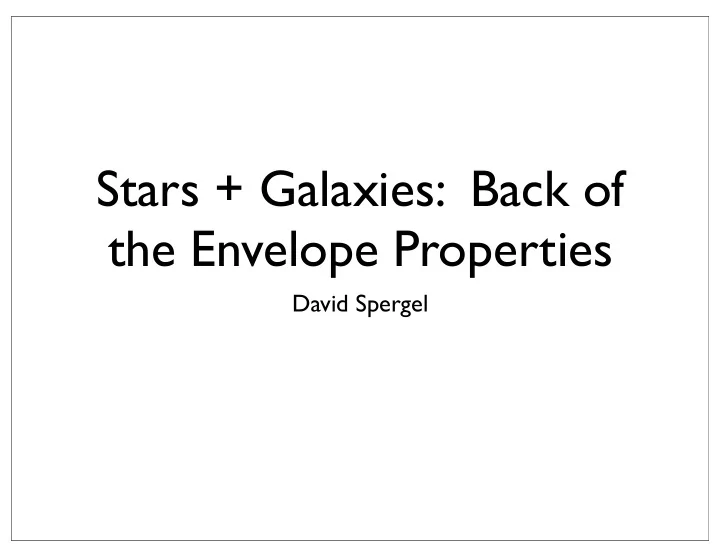

Stars + Galaxies: Back of the Envelope Properties David Spergel
Free-fall time r = − GM (1) ¨ r 2 t 2 = − GM r (2) r 2 r 3 1 (3) t free − fall ≃ √ Gρ GM ≃ Free-fall time for neutron star is milliseconds (char- acteristic timescale for gravitational waves) Free-fall time for the Sun is 10 3 s (characteristic timescale for gravitational waves) Characteristic time for universe = Hubble Time
Cosmology � ˙ � 2 a = 8 π 3 Gρ a t − 2 ∝ Gρ
Kelvin-Helmholtz Time • Time scale to radiate gravitational energy U = GM 2 /R t = GM 2 /RL 30 million years for the Sun Timescale for proto-star evolution
Einstein Time • Time scale to radiate gravitational energy U = Mc 2 t = Mc 2 /L 10 13 years for the Sun
Nuclear Energy Timescale U = ε Mc 2 t = ε Mc 2 /L • Helium burning is 7 MeV nucleon • Sun doesn’t use all of the available fuel • Lifetime ~ 10 10 years
Nuclear Burning � R = f ( v ) σ ( v ) dv � S ( E ) − m n v 2 � Z 1 Z 2 e 2 � � � v 2 exp exp ∝ 2 kT E hv
Stellar Structure • Hydrostatic Equilibrium: • Mass Conservation: • Thermal Conduction: • Equation of State: • Energy Production:
Hydrostatic Equilibrium dR = − GM ( r ) dp ρ R 2 ρ ≃ M ∗ /R 3 Using ¯ ∗ , this implies ∗ = GM 2 p ∗ = GM ∗ M ∗ R 3 ∗ R ∗ R 2 R 5 ∗ ∗ Using ideal gas law, p = ρkT/µ , kT = GMµ R
Mass-Luminosity Relation dR = − l ( r ) dT 3 κρ 4 πr 2 σ B T 3 16 ρ ≃ M ∗ /R 3 Using ¯ ∗ , this implies L = R 2 T 3 T ∗ ∗ ρ R ∗ L ∝ M 3 ∗
Mass Luminosity Relation
Stellar Lifetimes t = ǫMc 2 L t ∝ M − 2 Massive Stars live short brilliant lives!
Stellar Populations Mass function: dn dM ∝ M − 2 . 35 The lowest mass stars dominate the mass of a stel- lar population � M max ( t ) M − 2 . 35 L ( M ) dM = M 2 . 15 max ( t ) ∝ t − 1 . 07 L ( t ) = 0 The most massive stars dominate the luminosity of a population
Radii and Temperature R ∝ M 0 . 9 L ∝ T 4 R 2 T ∝ L 0 . 25 R 0 . 5 ∝ M 0 . 4
Spiral Arms
Later Stages of Stellar Evolution • Red Giant Branch (RGB) • Degenerate Core of Helium • Envelope burning Hydrogen • Helium Flash • Horizontal Branch • Core burning of Helium to Carbon • Asymptotic Giant Branch (AGB) • Degenerate Core of Carbon • Envelope burning Helium
Fuel Consumption Thereom The contribution by any Post Main Sequence evolutionary phase to the total luminosity of a simple stellar population is proportional to the amount of nuclear fuel burned in that phase t HB = L MS U HB ≃ L MS E He → C t MS L HB U MS L HB E H → He
Degeneracy Pressure • As a star burns H -> He, it leaves behind a degenerate gas supported by electron degeneracy pressure • Nuclear burning cycles are alternated by period of rapid gravitational collapse • Chandrasekhar Mass (maximum mass supported by degeneracy pressure) (followed by flashes)
Chandrasekhar Mass E G = − GM 2 R When the electrons become relativistic, their total Fermi energy is approximately, � � = N 4 / 3 � c = M 4 / 3 � c � E F = Ncp F = Nc m 4 / 3 ∆ x R p R Equating the two: � 3 / 2 1 = M 3 � � c Pl M ch = G m 2 m 2 p p
HR Diagram
Globular Cluster HR Diagram
Stellar Models • MESA (Paxton et al. 2011, ApJS, 192, 3) • mesa.sourceforge.net • Can stably evolve stars through Helium flash, RGB and HB to White Dwarf
Dust and Gas • Stars form in Molecular Clouds • These clouds contain copious amounts of dust that absorb starlight (in the optical, UV and near IR) and reemit in the IR • Dust grains are micron size and composed primarily of carbon and silicates
Dust Emission • Electric Dipole Limit (Size << λ ) σ abs ∝ λ − 2 F ν ∝ ν 2 B ν ( T ) ∝ ν 4
Galaxy Spectrum
Other Emission Processes • Radio: • Free-free emission • Synchrotron emission • Radio emission scales with synchrotron
X-ray UV VIS Near IR Mid IR Far IR Radio M81 D=3 Mpc
Galaxy Properties David Spergel
Tinker et al. 2008
Blanton et al. 2002 4 Gyr burst
4000 Angstrom Break
Kauffmann et al. 2003
Galaxy Morphology
Spiral Galaxies • Two parameter family: Luminosity and Surface Brightness • Exponential distribution of stars • Tully-Fisher Sanders and Verheijen 1998
Spiral Galaxy Formation • Tidal torque generates solid body rotation in gas • Gas cools and collapses to form a disk conserving angular momentum
Elliptical Galaxies • R e effective radius • I e mean surface brightness within eff. radius • σ 0 velocity dispersion log D n = log R e + 0.8 log I e
Black Hole Scaling Relation Gultekin et al. 2009
Recommend
More recommend